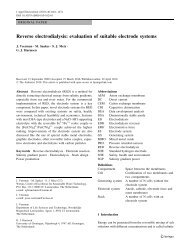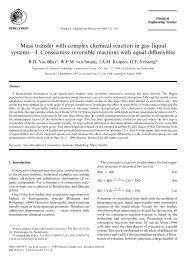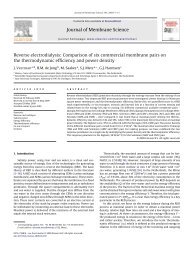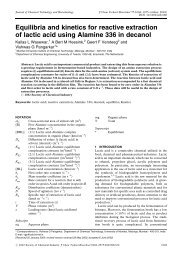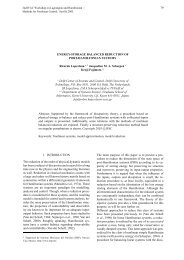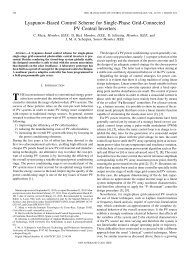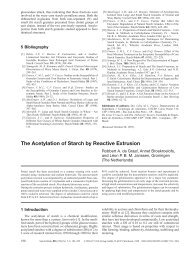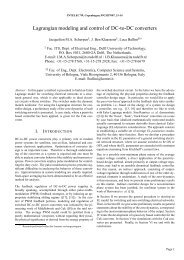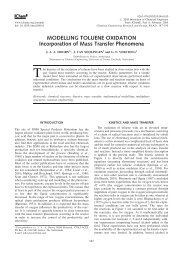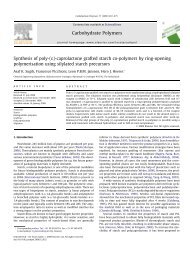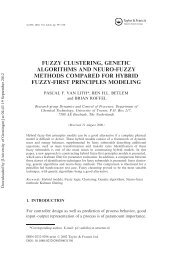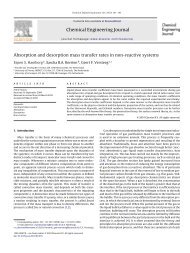1524 M. Seslija et al. / Journal of Geometry and Physics 62 (2012) 1509–1531where ⃗e ∗ p and ⃗e∗ q are integral forms on the primal mesh and its circumcentric dual, while ˙⃗ Rp and ˙⃗ Rq are time derivatives ofthe residues of the Hodge opera<strong>to</strong>r approximations given by∗ p ė c = p Mp,k˙⃗ep,k + ˙⃗ Rp,kˆσ p kσ ql∗ q ė c q = M q,l˙⃗e q,l + ˙⃗ Rq,l ,with subscripts k and l acting as selec<strong>to</strong>rs for vec<strong>to</strong>r components.Define discrete energy errors as δ⃗e p = ⃗e ∗ − p ⃗e p and δ⃗e q = ⃗e ∗ − q ⃗e q, and the output error as δ⃗ fb = ⃗ f∗− ⃗b fb .Subtracting (6.4) from (6.5) leads <strong>to</strong>− Mp δ˙⃗e p − ˙⃗ Rp = (−1) pq+1 D n−qiδ⃗e q + D n−qbδ⃗e ∗ b−M q δ˙⃗e q − ˙⃗ Rq = D n−p δ⃗e pδ⃗ fb = (−1) p T n−p δ⃗e p ,since δ⃗e b = ⃗e ∗ − b ⃗e b = ( ⋆σ n−q e c − b ⟨e b, ⋆σ n−qb⟩) n−qb⋆σ ∈∂(⋆K) = 0.bMultiplying the first equation in (6.6) by δ⃗e p and the second by δ⃗e q gives−⟨δ⃗e p , Mp δ˙⃗e p ⟩ − ⟨δ⃗e p , ˙⃗ Rp ⟩ = (−1) pq+1 ⟨δ⃗e p , D n−qiδ⃗e q ⟩−⟨δ⃗e q , M q δ˙⃗e q ⟩ − ⟨δ⃗e q , ˙⃗ Rq ⟩ = ⟨δ⃗e q , D n−p δ⃗e p ⟩.Then we haveThat is−⟨δ⃗e p , Mp δ˙⃗e p ⟩ − ⟨δ⃗e p , ˙⃗ Rp ⟩ − ⟨δ⃗e q , M q δ˙⃗e q ⟩ − ⟨δ⃗e q , ˙⃗ Rq ⟩ = (−1) pq+1 ⟨δ⃗e p , D n−qiδ⃗e q ⟩ + ⟨δ⃗e q , D n−p δ⃗e p ⟩ = 0.⟨δ⃗e p , Mp δ˙⃗e p ⟩ + ⟨δ⃗e q , M q δ˙⃗e q ⟩ = −⟨δ⃗e p , ˙⃗ Rp ⟩ − ⟨δ⃗e q˙⃗Rq ⟩. (6.7)Integration of (6.7) from 0 <strong>to</strong> t f yields12 M 122p δ⃗e p (t f ) + 1 12 M 2q δ⃗e q (t f )Let t ∗ be such thatM 122p δ⃗e p (t ∗ 1) + M 2q δ⃗e q (t ∗ )22= −≤ tf0 tf0⟨δ⃗e p (τ), ˙⃗ Rp (τ)⟩ + ⟨δ⃗e q (τ), ˙⃗ Rq (τ)⟩dτ∥˙⃗ Rp (τ)∥ ∥δ⃗e p (τ)∥ + ∥˙⃗ Rq (τ)∥ ∥δ⃗e q (τ)∥dτ. 11= max M 2p0≤t≤t f ∥δ⃗e p(t)∥ + M 2q ∥δ⃗e q∥,then 1M 2p δ⃗e p (t ∗ ) + 12 2Mq δ⃗e q (t ∗ 1) ≤ 2 M 2p δ⃗e p (t ∗ )≤ 4≤ 4 tf0 tf021+ M 2q δ⃗e q (t ∗ )It follows that M 12p δ⃗e p (t ∗ ) + 1tf 2Mq δ⃗e q (t ∗ ) ≤ 4 M − 1 2p˙⃗R p (τ) + M − 1 2q˙⃗R q (τ) dτ.Thus∥δ⃗e p (t ∗ )∥ + ∥δ⃗e q (t ∗ )∥ ≤ 4 M− 1 2p0 + ∞2 ∥˙⃗ Rp (τ)∥ ∥δ⃗e p (τ)∥ + ∥˙⃗ Rq (τ)∥ ∥δ⃗e q (τ)∥dτ 1M 2p δ⃗e p (t) + 12 −Mq δ⃗e q (t) 1 M2p˙⃗R p (τ) + M − 1 2q˙⃗R q (τ) dτ.1 M− 2q tf M − 1 2p˙⃗R p (τ) + M − 1 2q˙⃗R q (τ) dτ.∞0Estimation of the residues ⃗ Rp and ⃗ Rq can be conducted by employing Bramble–Hilbert techniques in the case of a weakformulation, or using a Taylor’s expansion of the efforts under the standard smoothness assumptions [27]. For the results onthe estimates of the Hodge star in one, two and three dimension the reader is invited <strong>to</strong> consult [27] and references therein.(6.6)
M. Seslija et al. / Journal of Geometry and Physics 62 (2012) 1509–1531 15257. Physical examplesIn this section we formulate discrete analogues of distributed-parameter port-Hamil<strong>to</strong>nian systems on a three-, two-,and one-dimensional manifold.7.1. Maxwell’s equationsLet K be a well-centered 3-dimensional manifold-like simplicial complex with circumcentric dual ⋆K , endowed with adiscrete Riemannian metric. Mirroring the continuous case [1], we formulate the discrete Maxwell’s equations in terms ofdiscrete differential forms, and then we demonstrate that the underpinning differential/gauge <strong>structure</strong> is preserved.The energy variables are chosen such that they live on the discrete manifolds that are dual <strong>to</strong> one another. For instance,we choose the magnetic (field) induction 2-form <strong>to</strong> be defined on the primal simplicial complex K as α q = B ∈ Ω 2 d(K) andthe electric induction 2-form ˆα p = ˆD ∈ Ω2(⋆ d i K). This means that B and ˆD do not reside at the same discrete locations, butrather at separate faces of staggered lattices.Remark 7.1. In the case of a spatio-temporal discretization based on the asynchronous variational integra<strong>to</strong>r scheme, asproposed in [14], the electric and magnetic induction are also defined at different time locations leading <strong>to</strong> improved numericperformance (for more details refer <strong>to</strong> [14]).The coenergy variables are chosen coherently as implied by the choice of the energy variables such that the discreteMaxwell’s equations fit the simplicial Dirac <strong>structure</strong> (4.2) for n = 3, p = q = 2. This entails that the magnetic fieldintensity ê q = Ĥ ∈ Ω 1(⋆ d i K) and the electric intensity e p = E ∈ Ω 1 d(K), as such, are related <strong>to</strong> the energy variables viaˆD = ∗ϵEB = ∗µĤ,where ϵ and µ denote the constant electric and magnetic permittivity, respectively.The corresponding simplicial Dirac <strong>structure</strong> is ˆfp 0 −di ep db=− êf qd 0 ê q 0 bf b = e p | ∂K .(7.1)The Hamil<strong>to</strong>nian is H = 1 ⟨E∧ ˆD+Ĥ2 ∧B, K⟩, or expressed only in terms of the primal forms as H = 1 ⟨E∧∗ϵE+ 1 ∗B∧B, K⟩.2 µUnder the assumption that there is no current in the medium, the spatially discretized Maxwell’s equations with respect<strong>to</strong> the simplicial Dirac <strong>structure</strong> (7.1) in the port-Hamil<strong>to</strong>nian form are given by⎛ ⎞⎛ ⎞∂H− ∂ ˆD ⎜ ∂t ⎟⎝− ∂B ⎠ = 0d 0∂tf b = ∂H∂ ˆD .∂K−di ⎜ ∂ ˆD⎟⎝∂Hˆ⎠ − db0∂Bê bThe readily proved energy balance is dH = ⟨êdt b ∧f b , ∂K⟩. Incorporating a nonzero current density in<strong>to</strong> the discrete Maxwell’sequations is straightforward as in the continuous case.7.2. The two-dimensional wave equationIn order <strong>to</strong> demonstrate practically that we do not face a problem of interconnection of the elementary Dirac <strong>structure</strong>sencountered in the mixed finite element method, as reported by Voss [31, see pages 183–196], we consider the simplicialDirac <strong>structure</strong> behind the discretized two-dimensional wave equation. The normalized wave equation is given by∂ 2 φ− φ = 0,∂t2 where φ is a smooth 0-form on a compact surface M ⊂ R 2 with a closed boundary, and ∆ is the Laplace opera<strong>to</strong>r.This equation, <strong>to</strong>gether with nonzero energy flow, can be formulated as a port-Hamil<strong>to</strong>nian system with boundary portvariables [32,8].The energy variables of the discretized system are chosen as follows: the kinetic momentum is a dual 2-form whosetime derivative is set <strong>to</strong> be ˆfp , the elastic strain is a primal 1-form with time derivative corresponding <strong>to</strong> f q , the coenergy(7.2)



